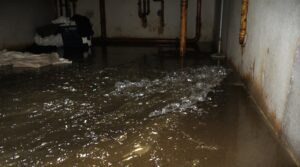Hurricane insurance and flood insurance are distinct policies serving different purposes in storm preparedness and flood prevention. Hurricane insurance provides financial protection against damage from hurricane-force winds (74 mph or higher), whereas flood insurance covers financial losses from flood-related damage due to severe weather. Individuals in hurricane-prone areas require hurricane insurance, while those in flood risk zones need flood insurance. Understanding both types of coverage is essential for thorough protection, with further exploration yielding more insight into tailored insurance coverage.
Key Takeaways
- Hurricane insurance and flood insurance serve different purposes, covering damage from high winds and water-related damage, respectively.
- Hurricane insurance focuses on storm wind damage, such as roof and window damage, while flood insurance covers storm surges and flash floods.
- Homeowners in storm surge risk areas should consider hurricane insurance, while flood insurance is required for those in Special Flood Hazard Areas (SFHAs).
- Premiums for hurricane and flood insurance vary based on location, property value, condition, and coverage level, among other factors.
- Understanding the differences between hurricane and flood insurance is crucial for comprehensive protection against natural disasters and financial losses.
What Is Hurricane Insurance?
Hurricane insurance is a type of property insurance that provides financial protection against damage or loss caused by hurricane-force winds, which are typically defined as sustained winds of 74 miles per hour or higher. This type of insurance is essential for individuals living in hurricane-prone areas, as it can help mitigate the financial burden of repairing or rebuilding a damaged property. Hurricane preparedness tips, such as installing storm shutters and securing outdoor furniture, can also help reduce the risk of damage and lower insurance premium factors. Insurance premium factors, including the location, value, and condition of the property, are used to determine the cost of hurricane insurance. By understanding these factors and taking proactive measures, individuals can minimize their risk and guarantee they have adequate coverage.
What Is Flood Insurance?
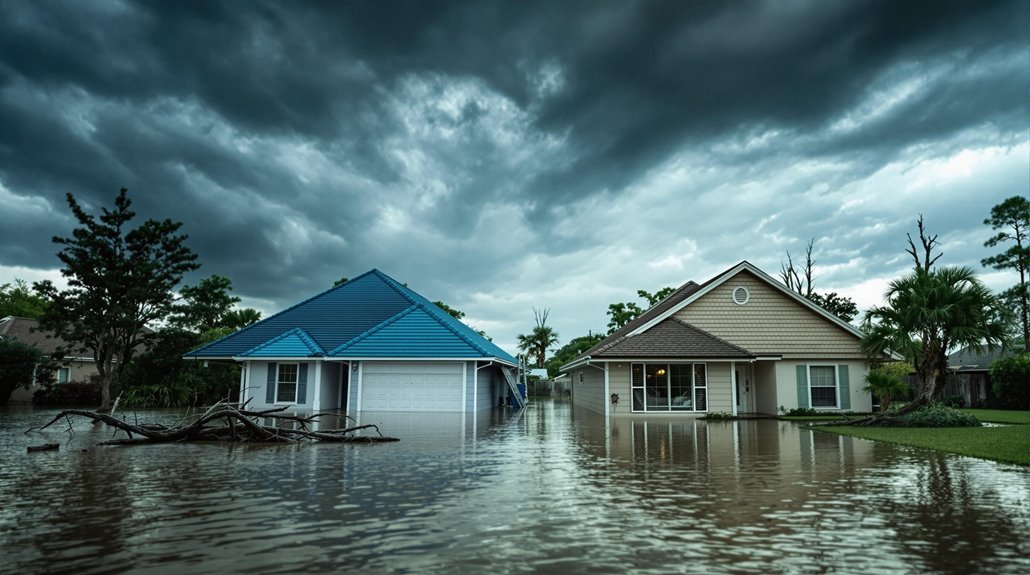
Flooding is a common consequence of severe weather events, including storms and heavy rainfall. Flood insurance is a type of coverage designed to protect individuals and businesses from financial losses resulting from flood-related damage. Understanding flood insurance basics is essential for those living in high-risk areas. A standard flood insurance policy typically covers damage to the building's structure, including walls, floors, and foundation, as well as personal property, such as furniture and appliances. There are various types of coverage available, including dwelling coverage, personal property coverage, and other structures coverage. Flood insurance is usually mandatory for properties located in high-risk flood areas, and it is also recommended for those living in low-to-moderate risk areas. Premiums vary depending on the location, type of property, and level of coverage chosen. Unlike standard property insurance, flood coverage includes temporary living expenses during necessary repairs when the home becomes uninhabitable due to flood damage.
Key Differences Between Hurricane and Flood Insurance
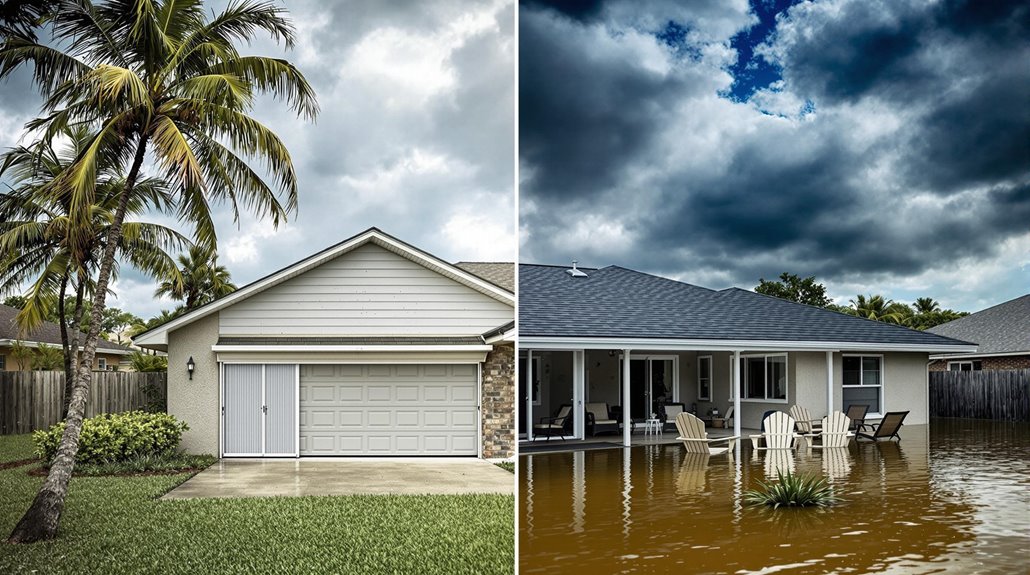
While storm-related damage can be devastating, the type of insurance coverage available to mitigate these losses is often misunderstood. Hurricane and flood insurance policies serve distinct purposes in hurricane preparedness and flood prevention strategies.
Key differences include:
* – Hurricane insurance typically covers damages from high winds, such as roof damage, shattered windows, and toppled trees, which compromise the structural integrity of homes.
– Flood insurance focuses on water-related damage**, including storm surges, flash floods, or heavy rainfall that inundates homes and businesses. Flood insurance is essential for homeowners and businesses situated in flood-prone areas, as it provides financial protection against significant repair costs. In addition to this coverage, understanding house flooding response steps can greatly mitigate damage and ensure safety during an emergency. These steps include creating an emergency plan, having essential supplies on hand, and knowing how to safely evacuate if necessary.
** – The location of a property and the type of perils it faces often dictate which type of insurance is most relevant for flood prevention or hurricane preparedness.
When Do You Need Hurricane Insurance?

Homeowners in storm surge risk areas, particularly those in low-lying coastal regions, may require hurricane insurance to mitigate potential damage from strong winds and flooding. The issuance of a tropical storm watch by the National Weather Service often prompts homeowners to reassess their insurance coverage, including the need for hurricane insurance. Understanding the category rating system, which classifies hurricanes based on wind speed and potential damage, can also inform decisions about when to purchase hurricane insurance.
Storm Surge Risk Areas
In coastal regions where the land meets the sea, a storm surge – a rise in sea level due to a storm, typically a hurricane – poses a significant threat to properties and human life, making hurricane insurance a necessary consideration for those residing in or owning properties within these high-risk areas. Coastal vulnerability to storm surge impacts is a major concern for property owners, residents, and the insurance industry as a whole.
Factors contributing to increased storm surge risk areas include:
- Exposed coastal location, where storm surges can cause extensive damage to properties
- Low elevation of properties, making them more prone to flooding
- Poor flood mitigation structures, including insufficient levees and seawalls that fail to protect against storm surges.
Tropical Storm Watches Issued
The issuance of a tropical storm watch serves as a vital indicator for property owners to reassess their insurance coverage. This alert is typically issued 48 hours prior to the storm's landfall, allowing individuals to review their policies and make necessary adjustments. Tropical storm preparedness is essential, and understanding the risks associated with these storms is imperative in determining the need for hurricane insurance. Understanding standard policy limitations is crucial when evaluating coverage needs during storm season.
| Storm Watch Alerts | Recommended Actions |
|---|---|
| Tropical Storm Watch | Review insurance policies, guarantee adequate coverage |
| Tropical Storm Warning | Finalize preparations, consider evacuating if necessary |
| Hurricane Watch | Confirm insurance coverage, prepare for potential damage |
| Hurricane Warning | Seek shelter, follow evacuation orders if issued |
Category Rating System Explained
While storm watches serve as an early warning for potential hurricanes, the category rating system provides a more precise measure of a storm's severity and potential damage. The category assessment is based on rating criteria that evaluate a storm's wind speed, central pressure, and potential damage. This system allows for a more accurate prediction of a storm's impact, enabling residents to make informed decisions regarding hurricane insurance.
The category rating system consists of the following criteria:
- Wind speed: Category 1: 74-95 mph Category 2: 96-110 mph * Category 3: 111-129 mph
- Storm surge: Category 1: 4-5 ft Category 2: 6-8 ft * Category 3: 9-12 ft
- Damage potential: Category 1: minimal damage Category 2: some roofing material, door, and window damage * Category 3: some structural damage to large buildings, especially those with exposed windows.
When Do You Need Flood Insurance?
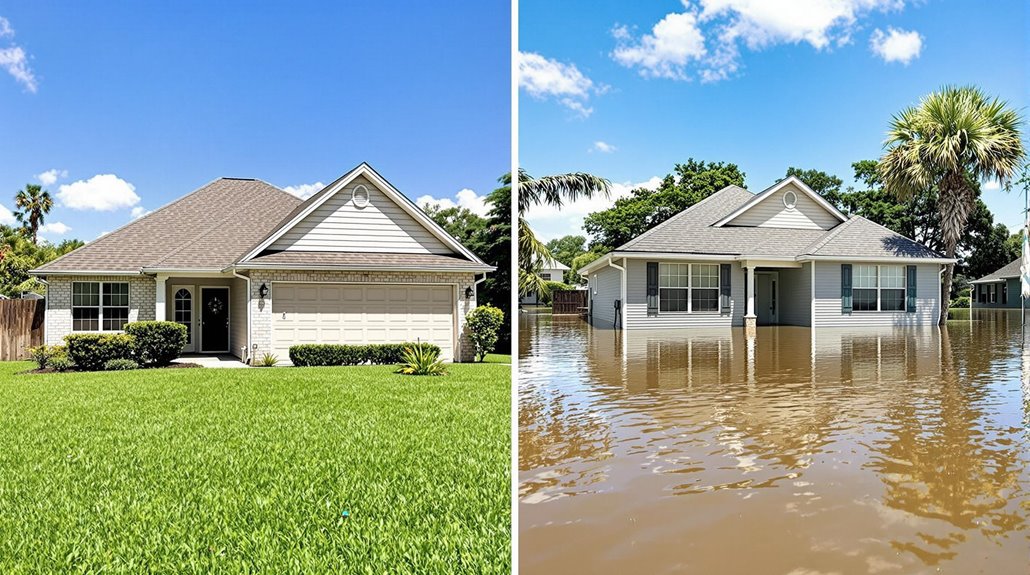
Homeowners living in designated high-risk flood areas are typically required to purchase flood insurance. These areas are often referred to as Special Flood Hazard Areas (SFHAs) or Mandatory Flood Zones, where the risk of flooding is higher due to the area's geography and flood history. Residents in these areas usually have limited options when it comes to purchasing insurance coverage.
Mandatory Flood Zones
Because flood risk varies considerably across different geographic areas, flood insurance is only mandatory in certain zones designated by the Federal Emergency Management Agency (FEMA). These mandatory flood zones are areas with a high risk of flooding, and property owners in these zones are required to purchase flood insurance as part of their mortgage requirements. Mandatory flood zones are designated based on factors such as flood frequency, flood severity, and the presence of flood-control measures.
- FEMA-designated zones A and AE are considered high-risk flood zones, and property owners in these zones are required to purchase flood insurance.
- Zone X is considered a moderate-to-low-risk flood zone, and flood insurance is not mandatory but may be recommended.
- Zone D is considered an undetermined-risk flood zone, and flood insurance may be required or recommended, depending on individual circumstances.
High-Risk Areas Coverage
The Federal Emergency Management Agency's (FEMA) flood zone designations provide a clear indication of flood risk, and property owners in high-risk areas are required to purchase flood insurance. High-risk zones are designated as Special Flood Hazard Areas (SFHA) and are identified as A or V zones on the Flood Insurance Rate Maps (FIRMs). Property owners in these zones are required to purchase flood insurance as a condition of their mortgage. Coverage options may vary depending on the location and type of property, but the National Flood Insurance Program (NFIP) and private flood insurance companies offer a range of policies to meet the needs of property owners in high-risk zones. Understanding flood risk and coverage options is essential for property owners in these areas.
Factors to Consider When Choosing Hurricane and Flood Insurance
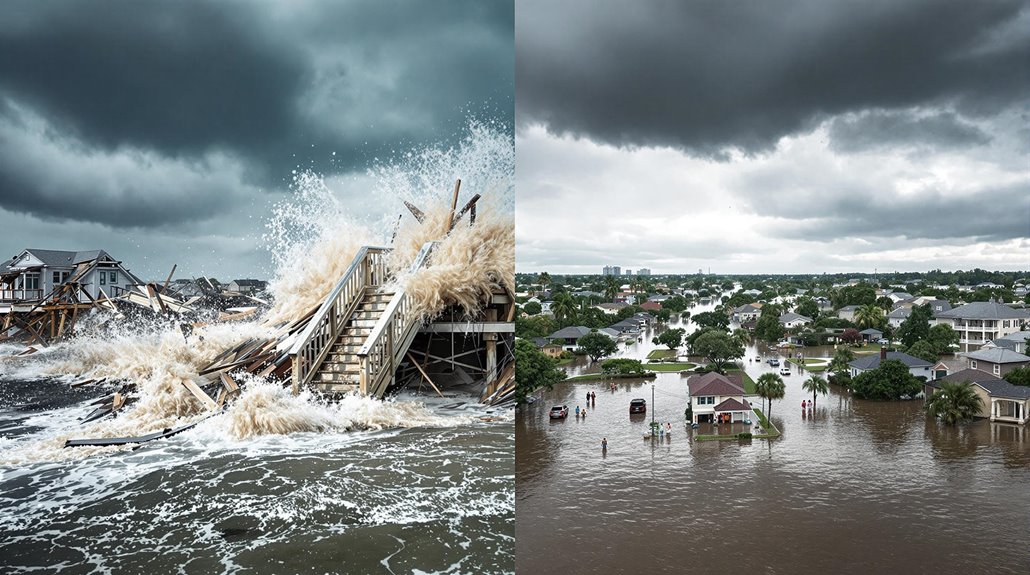
How do hurricane and flood insurance policies factor into an individual's overall risk management plan? When evaluating these policies, several factors come into play. To make informed decisions, individuals must consider their specific needs and circumstances. Liability coverage provides essential protection beyond just property damage in hurricane and flood scenarios.
- * Premium costs: Weighing the costs of premiums against potential losses in the event of a hurricane or flood
- * Coverage limits: Understanding the maximum amount the insurance policy will pay out for damages or losses
- * Policy exclusions: Recognizing what is not covered under the policy, such as maintenance-related damage or specific types of flooding, to guarantee adequate protection
Can Homeowners Get Both Hurricane and Flood Insurance Coverage?
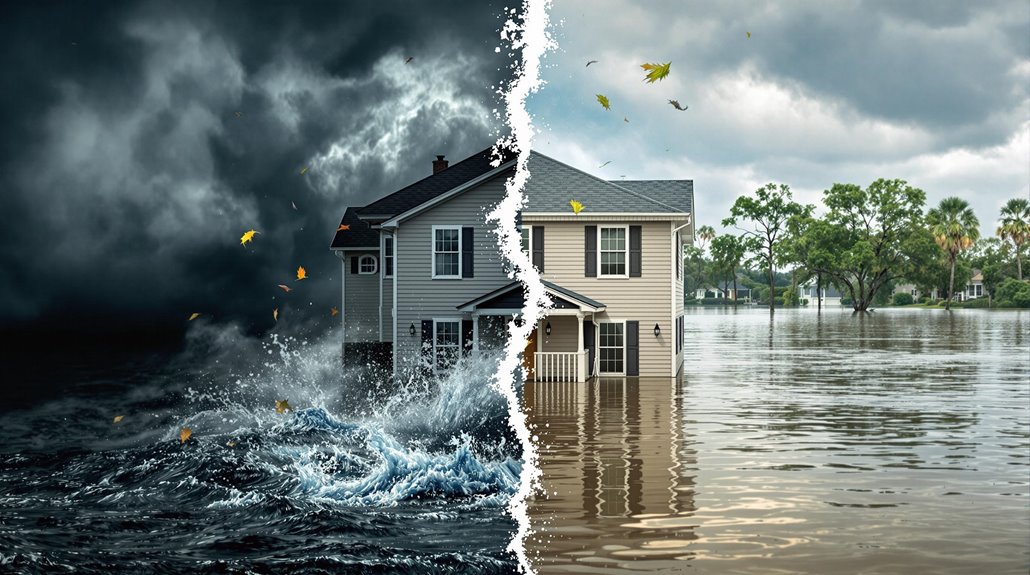
While hurricane and flood insurance policies serve distinct purposes, they can complement each other to provide extensive protection for homeowners. Homeowners have the option to purchase both hurricane and flood insurance policies to guarantee thorough coverage against the unique risks associated with each type of event. Insurance bundling, where multiple policies are purchased from the same provider, may offer discounts and streamlined claims processing. This approach allows homeowners to take advantage of the strengths of each policy, such as the broad wind-driven damage coverage offered by hurricane insurance and the specialized flood protection provided by flood insurance. By exploring these homeowner options, individuals can make informed decisions about their insurance coverage and better safeguard their properties against the unpredictable forces of nature.


